Sustainable and Responsible Management
VerifiedAdded on 2023/01/11
|16
|5252
|62
AI Summary
This document discusses sustainable and responsible management in the tourism industry. It covers the main features of sustainable tourism, the role of global organizations in promoting sustainable practices, principles of sustainable tourism, and approaches for measuring and monitoring sustainable performance. It also explores the purpose and principles of tourism development and planning to reduce adverse effects, evaluates the process of tourism development and associated challenges, and suggests different approaches for achieving sustainable objectives.
Contribute Materials
Your contribution can guide someone’s learning journey. Share your
documents today.
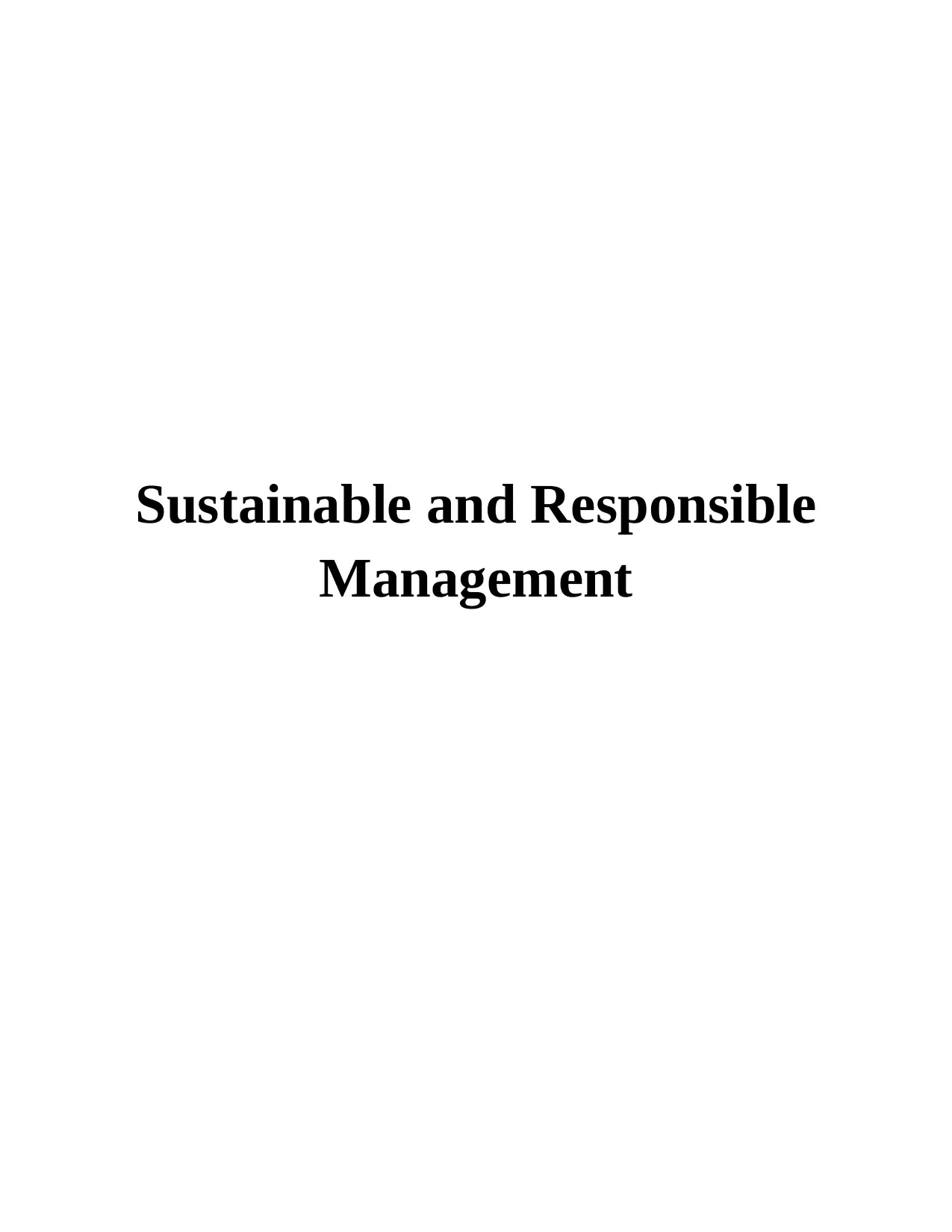
Sustainable and Responsible
Management
Management
Secure Best Marks with AI Grader
Need help grading? Try our AI Grader for instant feedback on your assignments.
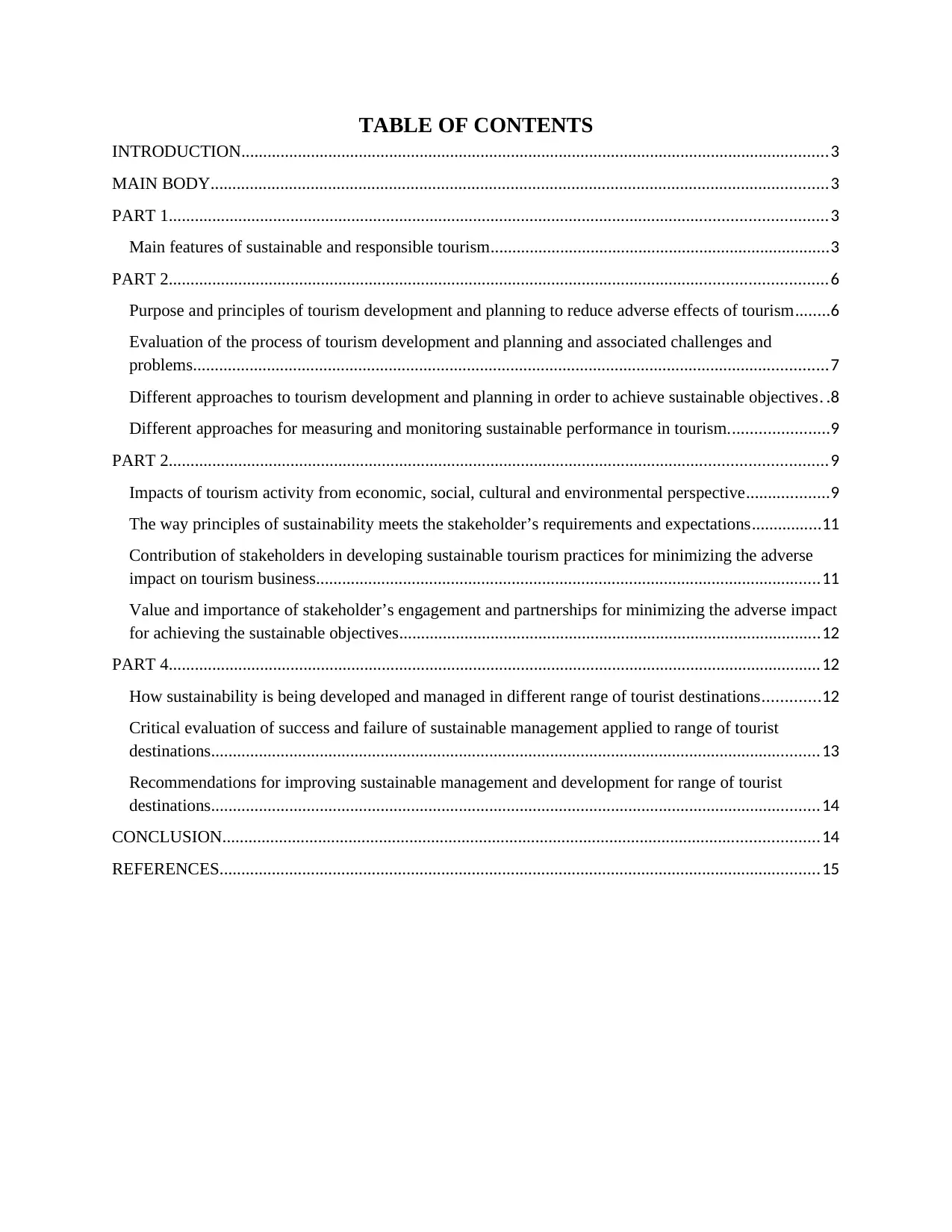
TABLE OF CONTENTS
INTRODUCTION.......................................................................................................................................3
MAIN BODY..............................................................................................................................................3
PART 1.......................................................................................................................................................3
Main features of sustainable and responsible tourism..............................................................................3
PART 2.......................................................................................................................................................6
Purpose and principles of tourism development and planning to reduce adverse effects of tourism........6
Evaluation of the process of tourism development and planning and associated challenges and
problems..................................................................................................................................................7
Different approaches to tourism development and planning in order to achieve sustainable objectives. .8
Different approaches for measuring and monitoring sustainable performance in tourism.......................9
PART 2.......................................................................................................................................................9
Impacts of tourism activity from economic, social, cultural and environmental perspective...................9
The way principles of sustainability meets the stakeholder’s requirements and expectations................11
Contribution of stakeholders in developing sustainable tourism practices for minimizing the adverse
impact on tourism business....................................................................................................................11
Value and importance of stakeholder’s engagement and partnerships for minimizing the adverse impact
for achieving the sustainable objectives.................................................................................................12
PART 4......................................................................................................................................................12
How sustainability is being developed and managed in different range of tourist destinations.............12
Critical evaluation of success and failure of sustainable management applied to range of tourist
destinations............................................................................................................................................13
Recommendations for improving sustainable management and development for range of tourist
destinations............................................................................................................................................14
CONCLUSION.........................................................................................................................................14
REFERENCES..........................................................................................................................................15
INTRODUCTION.......................................................................................................................................3
MAIN BODY..............................................................................................................................................3
PART 1.......................................................................................................................................................3
Main features of sustainable and responsible tourism..............................................................................3
PART 2.......................................................................................................................................................6
Purpose and principles of tourism development and planning to reduce adverse effects of tourism........6
Evaluation of the process of tourism development and planning and associated challenges and
problems..................................................................................................................................................7
Different approaches to tourism development and planning in order to achieve sustainable objectives. .8
Different approaches for measuring and monitoring sustainable performance in tourism.......................9
PART 2.......................................................................................................................................................9
Impacts of tourism activity from economic, social, cultural and environmental perspective...................9
The way principles of sustainability meets the stakeholder’s requirements and expectations................11
Contribution of stakeholders in developing sustainable tourism practices for minimizing the adverse
impact on tourism business....................................................................................................................11
Value and importance of stakeholder’s engagement and partnerships for minimizing the adverse impact
for achieving the sustainable objectives.................................................................................................12
PART 4......................................................................................................................................................12
How sustainability is being developed and managed in different range of tourist destinations.............12
Critical evaluation of success and failure of sustainable management applied to range of tourist
destinations............................................................................................................................................13
Recommendations for improving sustainable management and development for range of tourist
destinations............................................................................................................................................14
CONCLUSION.........................................................................................................................................14
REFERENCES..........................................................................................................................................15
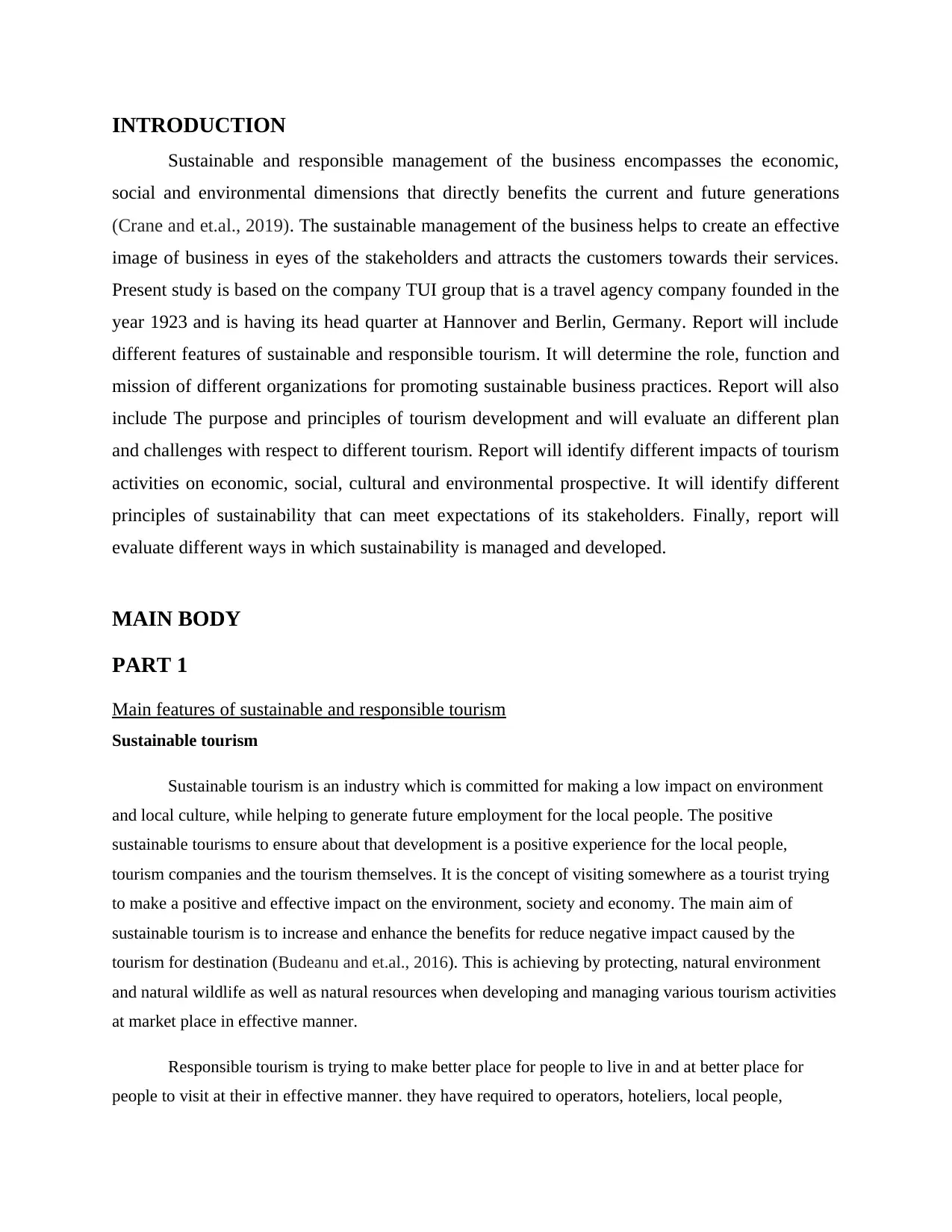
INTRODUCTION
Sustainable and responsible management of the business encompasses the economic,
social and environmental dimensions that directly benefits the current and future generations
(Crane and et.al., 2019). The sustainable management of the business helps to create an effective
image of business in eyes of the stakeholders and attracts the customers towards their services.
Present study is based on the company TUI group that is a travel agency company founded in the
year 1923 and is having its head quarter at Hannover and Berlin, Germany. Report will include
different features of sustainable and responsible tourism. It will determine the role, function and
mission of different organizations for promoting sustainable business practices. Report will also
include The purpose and principles of tourism development and will evaluate an different plan
and challenges with respect to different tourism. Report will identify different impacts of tourism
activities on economic, social, cultural and environmental prospective. It will identify different
principles of sustainability that can meet expectations of its stakeholders. Finally, report will
evaluate different ways in which sustainability is managed and developed.
MAIN BODY
PART 1
Main features of sustainable and responsible tourism
Sustainable tourism
Sustainable tourism is an industry which is committed for making a low impact on environment
and local culture, while helping to generate future employment for the local people. The positive
sustainable tourisms to ensure about that development is a positive experience for the local people,
tourism companies and the tourism themselves. It is the concept of visiting somewhere as a tourist trying
to make a positive and effective impact on the environment, society and economy. The main aim of
sustainable tourism is to increase and enhance the benefits for reduce negative impact caused by the
tourism for destination (Budeanu and et.al., 2016). This is achieving by protecting, natural environment
and natural wildlife as well as natural resources when developing and managing various tourism activities
at market place in effective manner.
Responsible tourism is trying to make better place for people to live in and at better place for
people to visit at their in effective manner. they have required to operators, hoteliers, local people,
Sustainable and responsible management of the business encompasses the economic,
social and environmental dimensions that directly benefits the current and future generations
(Crane and et.al., 2019). The sustainable management of the business helps to create an effective
image of business in eyes of the stakeholders and attracts the customers towards their services.
Present study is based on the company TUI group that is a travel agency company founded in the
year 1923 and is having its head quarter at Hannover and Berlin, Germany. Report will include
different features of sustainable and responsible tourism. It will determine the role, function and
mission of different organizations for promoting sustainable business practices. Report will also
include The purpose and principles of tourism development and will evaluate an different plan
and challenges with respect to different tourism. Report will identify different impacts of tourism
activities on economic, social, cultural and environmental prospective. It will identify different
principles of sustainability that can meet expectations of its stakeholders. Finally, report will
evaluate different ways in which sustainability is managed and developed.
MAIN BODY
PART 1
Main features of sustainable and responsible tourism
Sustainable tourism
Sustainable tourism is an industry which is committed for making a low impact on environment
and local culture, while helping to generate future employment for the local people. The positive
sustainable tourisms to ensure about that development is a positive experience for the local people,
tourism companies and the tourism themselves. It is the concept of visiting somewhere as a tourist trying
to make a positive and effective impact on the environment, society and economy. The main aim of
sustainable tourism is to increase and enhance the benefits for reduce negative impact caused by the
tourism for destination (Budeanu and et.al., 2016). This is achieving by protecting, natural environment
and natural wildlife as well as natural resources when developing and managing various tourism activities
at market place in effective manner.
Responsible tourism is trying to make better place for people to live in and at better place for
people to visit at their in effective manner. they have required to operators, hoteliers, local people,
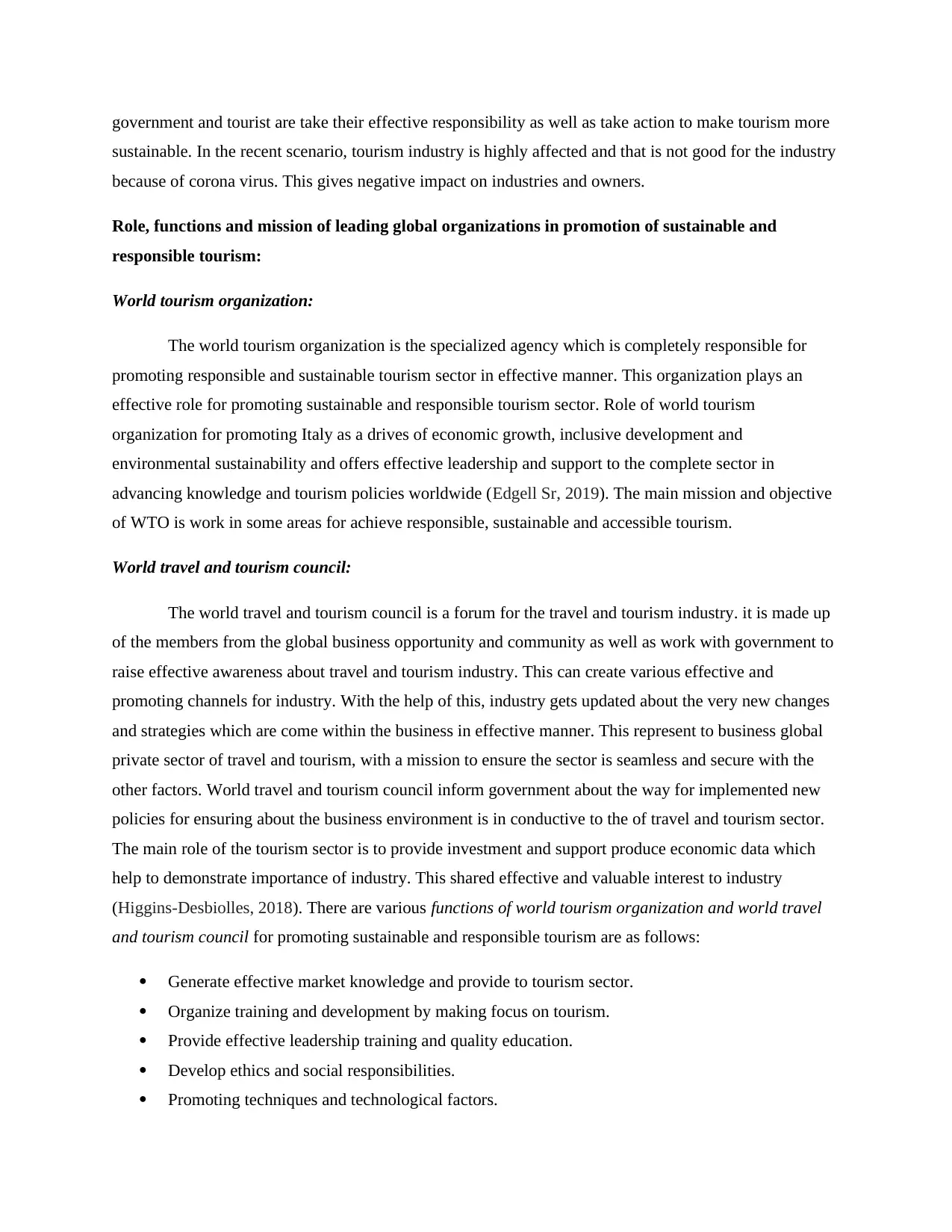
government and tourist are take their effective responsibility as well as take action to make tourism more
sustainable. In the recent scenario, tourism industry is highly affected and that is not good for the industry
because of corona virus. This gives negative impact on industries and owners.
Role, functions and mission of leading global organizations in promotion of sustainable and
responsible tourism:
World tourism organization:
The world tourism organization is the specialized agency which is completely responsible for
promoting responsible and sustainable tourism sector in effective manner. This organization plays an
effective role for promoting sustainable and responsible tourism sector. Role of world tourism
organization for promoting Italy as a drives of economic growth, inclusive development and
environmental sustainability and offers effective leadership and support to the complete sector in
advancing knowledge and tourism policies worldwide (Edgell Sr, 2019). The main mission and objective
of WTO is work in some areas for achieve responsible, sustainable and accessible tourism.
World travel and tourism council:
The world travel and tourism council is a forum for the travel and tourism industry. it is made up
of the members from the global business opportunity and community as well as work with government to
raise effective awareness about travel and tourism industry. This can create various effective and
promoting channels for industry. With the help of this, industry gets updated about the very new changes
and strategies which are come within the business in effective manner. This represent to business global
private sector of travel and tourism, with a mission to ensure the sector is seamless and secure with the
other factors. World travel and tourism council inform government about the way for implemented new
policies for ensuring about the business environment is in conductive to the of travel and tourism sector.
The main role of the tourism sector is to provide investment and support produce economic data which
help to demonstrate importance of industry. This shared effective and valuable interest to industry
(Higgins-Desbiolles, 2018). There are various functions of world tourism organization and world travel
and tourism council for promoting sustainable and responsible tourism are as follows:
Generate effective market knowledge and provide to tourism sector.
Organize training and development by making focus on tourism.
Provide effective leadership training and quality education.
Develop ethics and social responsibilities.
Promoting techniques and technological factors.
sustainable. In the recent scenario, tourism industry is highly affected and that is not good for the industry
because of corona virus. This gives negative impact on industries and owners.
Role, functions and mission of leading global organizations in promotion of sustainable and
responsible tourism:
World tourism organization:
The world tourism organization is the specialized agency which is completely responsible for
promoting responsible and sustainable tourism sector in effective manner. This organization plays an
effective role for promoting sustainable and responsible tourism sector. Role of world tourism
organization for promoting Italy as a drives of economic growth, inclusive development and
environmental sustainability and offers effective leadership and support to the complete sector in
advancing knowledge and tourism policies worldwide (Edgell Sr, 2019). The main mission and objective
of WTO is work in some areas for achieve responsible, sustainable and accessible tourism.
World travel and tourism council:
The world travel and tourism council is a forum for the travel and tourism industry. it is made up
of the members from the global business opportunity and community as well as work with government to
raise effective awareness about travel and tourism industry. This can create various effective and
promoting channels for industry. With the help of this, industry gets updated about the very new changes
and strategies which are come within the business in effective manner. This represent to business global
private sector of travel and tourism, with a mission to ensure the sector is seamless and secure with the
other factors. World travel and tourism council inform government about the way for implemented new
policies for ensuring about the business environment is in conductive to the of travel and tourism sector.
The main role of the tourism sector is to provide investment and support produce economic data which
help to demonstrate importance of industry. This shared effective and valuable interest to industry
(Higgins-Desbiolles, 2018). There are various functions of world tourism organization and world travel
and tourism council for promoting sustainable and responsible tourism are as follows:
Generate effective market knowledge and provide to tourism sector.
Organize training and development by making focus on tourism.
Provide effective leadership training and quality education.
Develop ethics and social responsibilities.
Promoting techniques and technological factors.
Secure Best Marks with AI Grader
Need help grading? Try our AI Grader for instant feedback on your assignments.
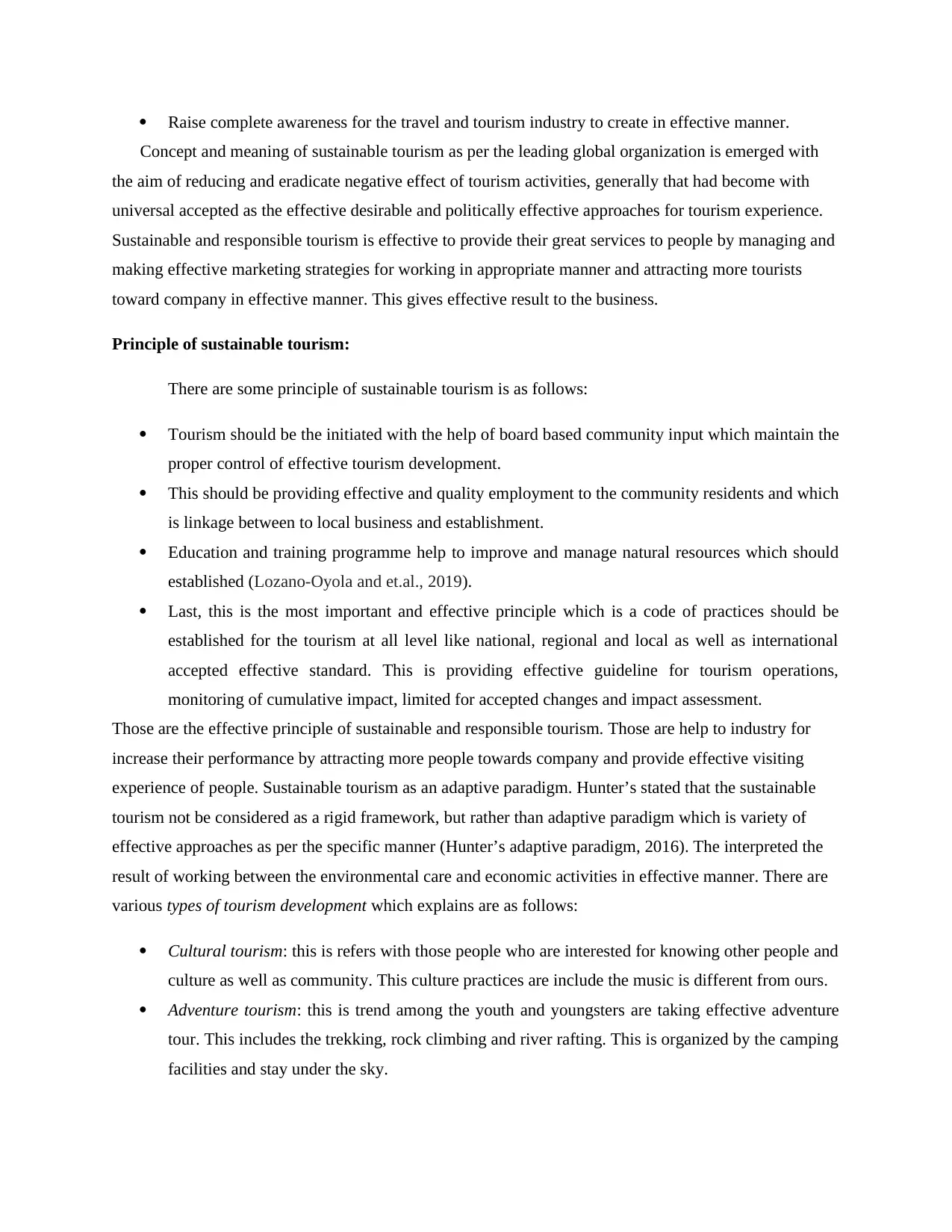
Raise complete awareness for the travel and tourism industry to create in effective manner.
Concept and meaning of sustainable tourism as per the leading global organization is emerged with
the aim of reducing and eradicate negative effect of tourism activities, generally that had become with
universal accepted as the effective desirable and politically effective approaches for tourism experience.
Sustainable and responsible tourism is effective to provide their great services to people by managing and
making effective marketing strategies for working in appropriate manner and attracting more tourists
toward company in effective manner. This gives effective result to the business.
Principle of sustainable tourism:
There are some principle of sustainable tourism is as follows:
Tourism should be the initiated with the help of board based community input which maintain the
proper control of effective tourism development.
This should be providing effective and quality employment to the community residents and which
is linkage between to local business and establishment.
Education and training programme help to improve and manage natural resources which should
established (Lozano-Oyola and et.al., 2019).
Last, this is the most important and effective principle which is a code of practices should be
established for the tourism at all level like national, regional and local as well as international
accepted effective standard. This is providing effective guideline for tourism operations,
monitoring of cumulative impact, limited for accepted changes and impact assessment.
Those are the effective principle of sustainable and responsible tourism. Those are help to industry for
increase their performance by attracting more people towards company and provide effective visiting
experience of people. Sustainable tourism as an adaptive paradigm. Hunter’s stated that the sustainable
tourism not be considered as a rigid framework, but rather than adaptive paradigm which is variety of
effective approaches as per the specific manner (Hunter’s adaptive paradigm, 2016). The interpreted the
result of working between the environmental care and economic activities in effective manner. There are
various types of tourism development which explains are as follows:
Cultural tourism: this is refers with those people who are interested for knowing other people and
culture as well as community. This culture practices are include the music is different from ours.
Adventure tourism: this is trend among the youth and youngsters are taking effective adventure
tour. This includes the trekking, rock climbing and river rafting. This is organized by the camping
facilities and stay under the sky.
Concept and meaning of sustainable tourism as per the leading global organization is emerged with
the aim of reducing and eradicate negative effect of tourism activities, generally that had become with
universal accepted as the effective desirable and politically effective approaches for tourism experience.
Sustainable and responsible tourism is effective to provide their great services to people by managing and
making effective marketing strategies for working in appropriate manner and attracting more tourists
toward company in effective manner. This gives effective result to the business.
Principle of sustainable tourism:
There are some principle of sustainable tourism is as follows:
Tourism should be the initiated with the help of board based community input which maintain the
proper control of effective tourism development.
This should be providing effective and quality employment to the community residents and which
is linkage between to local business and establishment.
Education and training programme help to improve and manage natural resources which should
established (Lozano-Oyola and et.al., 2019).
Last, this is the most important and effective principle which is a code of practices should be
established for the tourism at all level like national, regional and local as well as international
accepted effective standard. This is providing effective guideline for tourism operations,
monitoring of cumulative impact, limited for accepted changes and impact assessment.
Those are the effective principle of sustainable and responsible tourism. Those are help to industry for
increase their performance by attracting more people towards company and provide effective visiting
experience of people. Sustainable tourism as an adaptive paradigm. Hunter’s stated that the sustainable
tourism not be considered as a rigid framework, but rather than adaptive paradigm which is variety of
effective approaches as per the specific manner (Hunter’s adaptive paradigm, 2016). The interpreted the
result of working between the environmental care and economic activities in effective manner. There are
various types of tourism development which explains are as follows:
Cultural tourism: this is refers with those people who are interested for knowing other people and
culture as well as community. This culture practices are include the music is different from ours.
Adventure tourism: this is trend among the youth and youngsters are taking effective adventure
tour. This includes the trekking, rock climbing and river rafting. This is organized by the camping
facilities and stay under the sky.
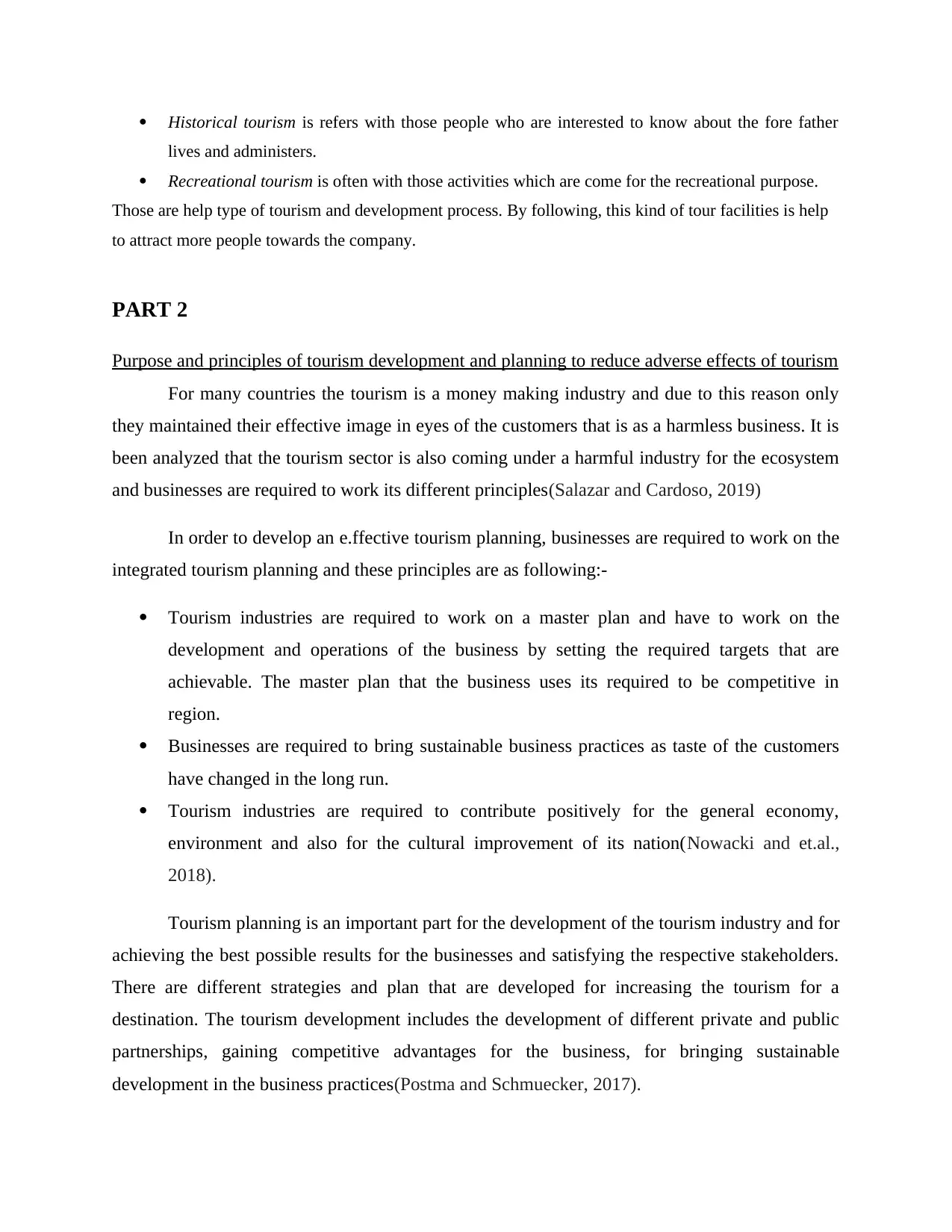
Historical tourism is refers with those people who are interested to know about the fore father
lives and administers.
Recreational tourism is often with those activities which are come for the recreational purpose.
Those are help type of tourism and development process. By following, this kind of tour facilities is help
to attract more people towards the company.
PART 2
Purpose and principles of tourism development and planning to reduce adverse effects of tourism
For many countries the tourism is a money making industry and due to this reason only
they maintained their effective image in eyes of the customers that is as a harmless business. It is
been analyzed that the tourism sector is also coming under a harmful industry for the ecosystem
and businesses are required to work its different principles(Salazar and Cardoso, 2019)
In order to develop an e.ffective tourism planning, businesses are required to work on the
integrated tourism planning and these principles are as following:-
Tourism industries are required to work on a master plan and have to work on the
development and operations of the business by setting the required targets that are
achievable. The master plan that the business uses its required to be competitive in
region.
Businesses are required to bring sustainable business practices as taste of the customers
have changed in the long run.
Tourism industries are required to contribute positively for the general economy,
environment and also for the cultural improvement of its nation(Nowacki and et.al.,
2018).
Tourism planning is an important part for the development of the tourism industry and for
achieving the best possible results for the businesses and satisfying the respective stakeholders.
There are different strategies and plan that are developed for increasing the tourism for a
destination. The tourism development includes the development of different private and public
partnerships, gaining competitive advantages for the business, for bringing sustainable
development in the business practices(Postma and Schmuecker, 2017).
lives and administers.
Recreational tourism is often with those activities which are come for the recreational purpose.
Those are help type of tourism and development process. By following, this kind of tour facilities is help
to attract more people towards the company.
PART 2
Purpose and principles of tourism development and planning to reduce adverse effects of tourism
For many countries the tourism is a money making industry and due to this reason only
they maintained their effective image in eyes of the customers that is as a harmless business. It is
been analyzed that the tourism sector is also coming under a harmful industry for the ecosystem
and businesses are required to work its different principles(Salazar and Cardoso, 2019)
In order to develop an e.ffective tourism planning, businesses are required to work on the
integrated tourism planning and these principles are as following:-
Tourism industries are required to work on a master plan and have to work on the
development and operations of the business by setting the required targets that are
achievable. The master plan that the business uses its required to be competitive in
region.
Businesses are required to bring sustainable business practices as taste of the customers
have changed in the long run.
Tourism industries are required to contribute positively for the general economy,
environment and also for the cultural improvement of its nation(Nowacki and et.al.,
2018).
Tourism planning is an important part for the development of the tourism industry and for
achieving the best possible results for the businesses and satisfying the respective stakeholders.
There are different strategies and plan that are developed for increasing the tourism for a
destination. The tourism development includes the development of different private and public
partnerships, gaining competitive advantages for the business, for bringing sustainable
development in the business practices(Postma and Schmuecker, 2017).
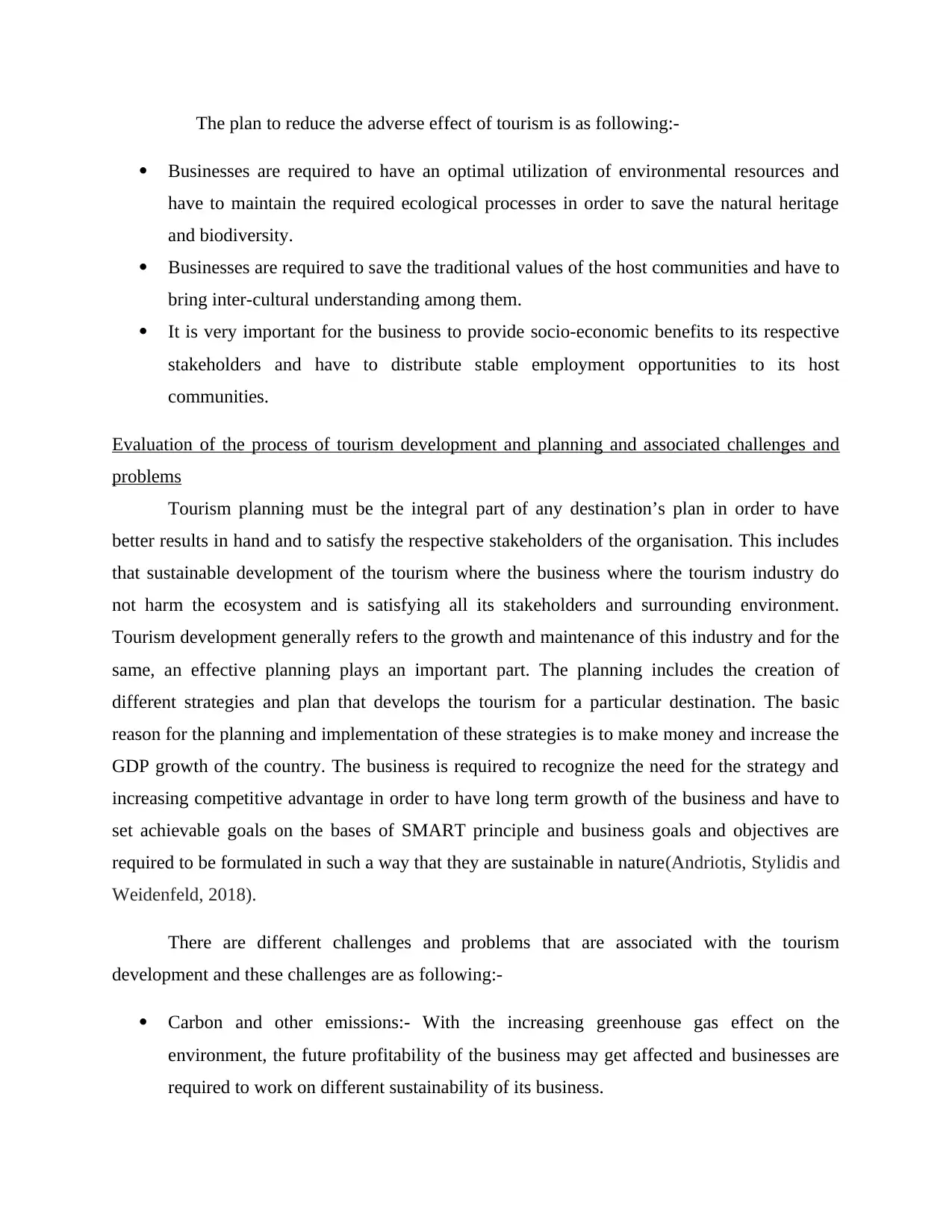
The plan to reduce the adverse effect of tourism is as following:-
Businesses are required to have an optimal utilization of environmental resources and
have to maintain the required ecological processes in order to save the natural heritage
and biodiversity.
Businesses are required to save the traditional values of the host communities and have to
bring inter-cultural understanding among them.
It is very important for the business to provide socio-economic benefits to its respective
stakeholders and have to distribute stable employment opportunities to its host
communities.
Evaluation of the process of tourism development and planning and associated challenges and
problems
Tourism planning must be the integral part of any destination’s plan in order to have
better results in hand and to satisfy the respective stakeholders of the organisation. This includes
that sustainable development of the tourism where the business where the tourism industry do
not harm the ecosystem and is satisfying all its stakeholders and surrounding environment.
Tourism development generally refers to the growth and maintenance of this industry and for the
same, an effective planning plays an important part. The planning includes the creation of
different strategies and plan that develops the tourism for a particular destination. The basic
reason for the planning and implementation of these strategies is to make money and increase the
GDP growth of the country. The business is required to recognize the need for the strategy and
increasing competitive advantage in order to have long term growth of the business and have to
set achievable goals on the bases of SMART principle and business goals and objectives are
required to be formulated in such a way that they are sustainable in nature(Andriotis, Stylidis and
Weidenfeld, 2018).
There are different challenges and problems that are associated with the tourism
development and these challenges are as following:-
Carbon and other emissions:- With the increasing greenhouse gas effect on the
environment, the future profitability of the business may get affected and businesses are
required to work on different sustainability of its business.
Businesses are required to have an optimal utilization of environmental resources and
have to maintain the required ecological processes in order to save the natural heritage
and biodiversity.
Businesses are required to save the traditional values of the host communities and have to
bring inter-cultural understanding among them.
It is very important for the business to provide socio-economic benefits to its respective
stakeholders and have to distribute stable employment opportunities to its host
communities.
Evaluation of the process of tourism development and planning and associated challenges and
problems
Tourism planning must be the integral part of any destination’s plan in order to have
better results in hand and to satisfy the respective stakeholders of the organisation. This includes
that sustainable development of the tourism where the business where the tourism industry do
not harm the ecosystem and is satisfying all its stakeholders and surrounding environment.
Tourism development generally refers to the growth and maintenance of this industry and for the
same, an effective planning plays an important part. The planning includes the creation of
different strategies and plan that develops the tourism for a particular destination. The basic
reason for the planning and implementation of these strategies is to make money and increase the
GDP growth of the country. The business is required to recognize the need for the strategy and
increasing competitive advantage in order to have long term growth of the business and have to
set achievable goals on the bases of SMART principle and business goals and objectives are
required to be formulated in such a way that they are sustainable in nature(Andriotis, Stylidis and
Weidenfeld, 2018).
There are different challenges and problems that are associated with the tourism
development and these challenges are as following:-
Carbon and other emissions:- With the increasing greenhouse gas effect on the
environment, the future profitability of the business may get affected and businesses are
required to work on different sustainability of its business.
Paraphrase This Document
Need a fresh take? Get an instant paraphrase of this document with our AI Paraphraser
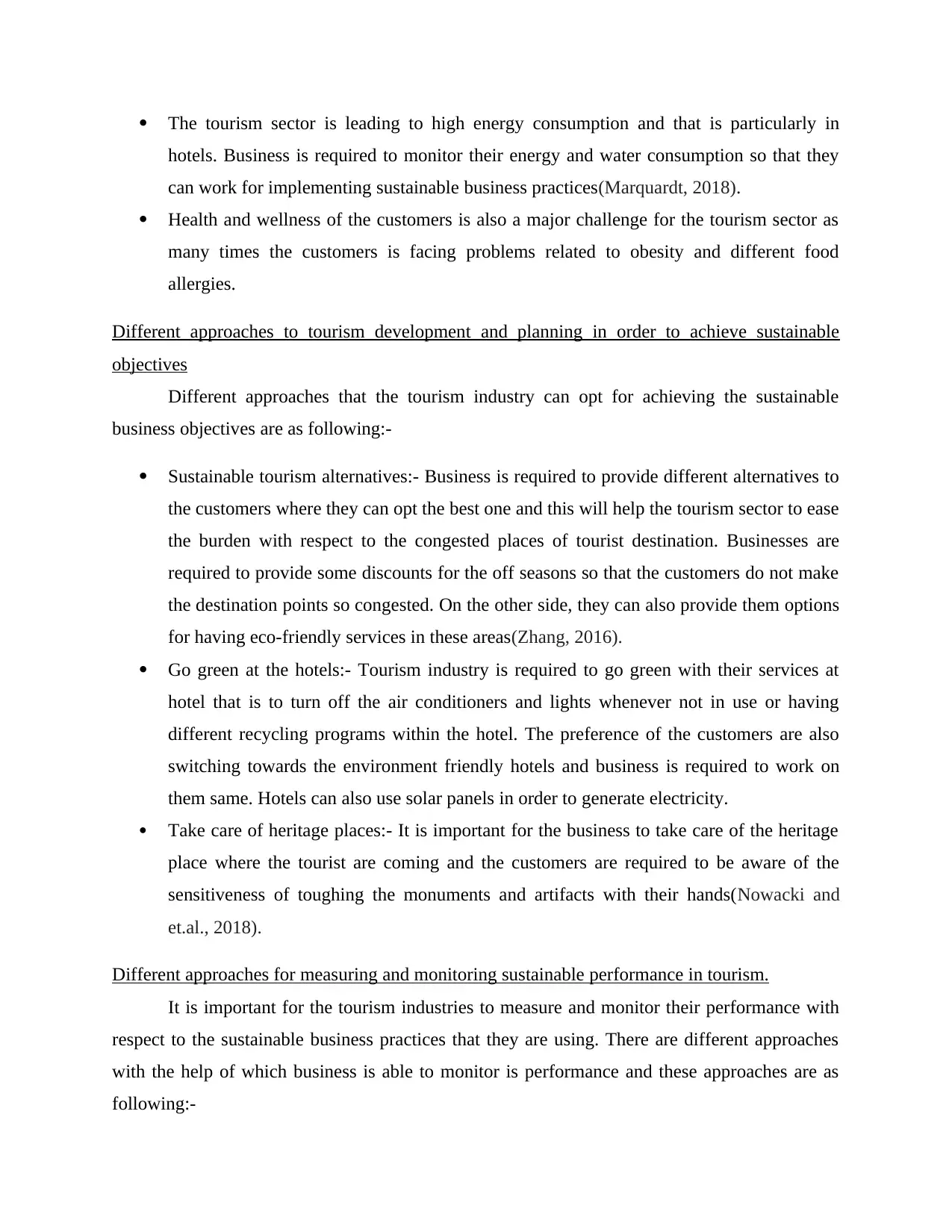
The tourism sector is leading to high energy consumption and that is particularly in
hotels. Business is required to monitor their energy and water consumption so that they
can work for implementing sustainable business practices(Marquardt, 2018).
Health and wellness of the customers is also a major challenge for the tourism sector as
many times the customers is facing problems related to obesity and different food
allergies.
Different approaches to tourism development and planning in order to achieve sustainable
objectives
Different approaches that the tourism industry can opt for achieving the sustainable
business objectives are as following:-
Sustainable tourism alternatives:- Business is required to provide different alternatives to
the customers where they can opt the best one and this will help the tourism sector to ease
the burden with respect to the congested places of tourist destination. Businesses are
required to provide some discounts for the off seasons so that the customers do not make
the destination points so congested. On the other side, they can also provide them options
for having eco-friendly services in these areas(Zhang, 2016).
Go green at the hotels:- Tourism industry is required to go green with their services at
hotel that is to turn off the air conditioners and lights whenever not in use or having
different recycling programs within the hotel. The preference of the customers are also
switching towards the environment friendly hotels and business is required to work on
them same. Hotels can also use solar panels in order to generate electricity.
Take care of heritage places:- It is important for the business to take care of the heritage
place where the tourist are coming and the customers are required to be aware of the
sensitiveness of toughing the monuments and artifacts with their hands(Nowacki and
et.al., 2018).
Different approaches for measuring and monitoring sustainable performance in tourism.
It is important for the tourism industries to measure and monitor their performance with
respect to the sustainable business practices that they are using. There are different approaches
with the help of which business is able to monitor is performance and these approaches are as
following:-
hotels. Business is required to monitor their energy and water consumption so that they
can work for implementing sustainable business practices(Marquardt, 2018).
Health and wellness of the customers is also a major challenge for the tourism sector as
many times the customers is facing problems related to obesity and different food
allergies.
Different approaches to tourism development and planning in order to achieve sustainable
objectives
Different approaches that the tourism industry can opt for achieving the sustainable
business objectives are as following:-
Sustainable tourism alternatives:- Business is required to provide different alternatives to
the customers where they can opt the best one and this will help the tourism sector to ease
the burden with respect to the congested places of tourist destination. Businesses are
required to provide some discounts for the off seasons so that the customers do not make
the destination points so congested. On the other side, they can also provide them options
for having eco-friendly services in these areas(Zhang, 2016).
Go green at the hotels:- Tourism industry is required to go green with their services at
hotel that is to turn off the air conditioners and lights whenever not in use or having
different recycling programs within the hotel. The preference of the customers are also
switching towards the environment friendly hotels and business is required to work on
them same. Hotels can also use solar panels in order to generate electricity.
Take care of heritage places:- It is important for the business to take care of the heritage
place where the tourist are coming and the customers are required to be aware of the
sensitiveness of toughing the monuments and artifacts with their hands(Nowacki and
et.al., 2018).
Different approaches for measuring and monitoring sustainable performance in tourism.
It is important for the tourism industries to measure and monitor their performance with
respect to the sustainable business practices that they are using. There are different approaches
with the help of which business is able to monitor is performance and these approaches are as
following:-
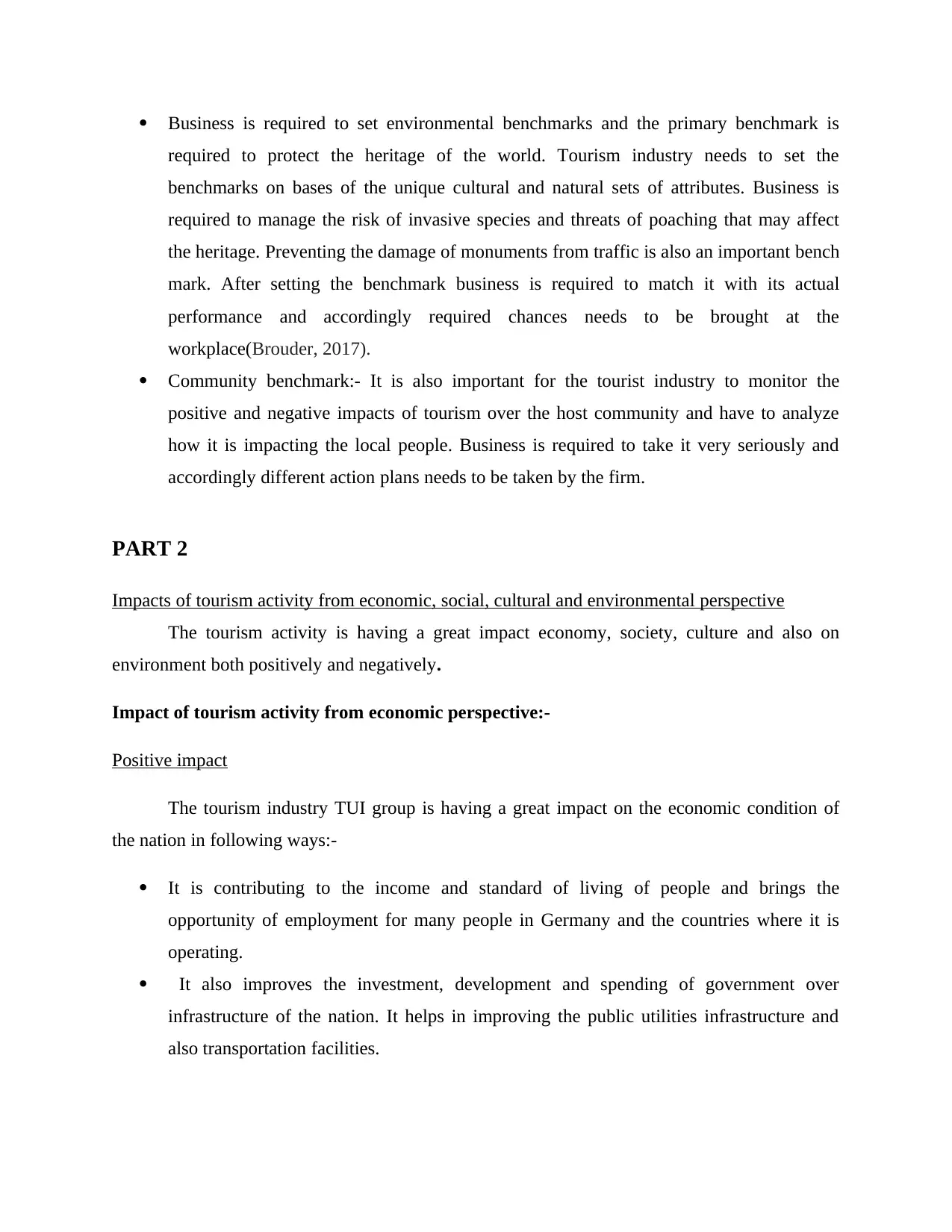
Business is required to set environmental benchmarks and the primary benchmark is
required to protect the heritage of the world. Tourism industry needs to set the
benchmarks on bases of the unique cultural and natural sets of attributes. Business is
required to manage the risk of invasive species and threats of poaching that may affect
the heritage. Preventing the damage of monuments from traffic is also an important bench
mark. After setting the benchmark business is required to match it with its actual
performance and accordingly required chances needs to be brought at the
workplace(Brouder, 2017).
Community benchmark:- It is also important for the tourist industry to monitor the
positive and negative impacts of tourism over the host community and have to analyze
how it is impacting the local people. Business is required to take it very seriously and
accordingly different action plans needs to be taken by the firm.
PART 2
Impacts of tourism activity from economic, social, cultural and environmental perspective
The tourism activity is having a great impact economy, society, culture and also on
environment both positively and negatively.
Impact of tourism activity from economic perspective:-
Positive impact
The tourism industry TUI group is having a great impact on the economic condition of
the nation in following ways:-
It is contributing to the income and standard of living of people and brings the
opportunity of employment for many people in Germany and the countries where it is
operating.
It also improves the investment, development and spending of government over
infrastructure of the nation. It helps in improving the public utilities infrastructure and
also transportation facilities.
required to protect the heritage of the world. Tourism industry needs to set the
benchmarks on bases of the unique cultural and natural sets of attributes. Business is
required to manage the risk of invasive species and threats of poaching that may affect
the heritage. Preventing the damage of monuments from traffic is also an important bench
mark. After setting the benchmark business is required to match it with its actual
performance and accordingly required chances needs to be brought at the
workplace(Brouder, 2017).
Community benchmark:- It is also important for the tourist industry to monitor the
positive and negative impacts of tourism over the host community and have to analyze
how it is impacting the local people. Business is required to take it very seriously and
accordingly different action plans needs to be taken by the firm.
PART 2
Impacts of tourism activity from economic, social, cultural and environmental perspective
The tourism activity is having a great impact economy, society, culture and also on
environment both positively and negatively.
Impact of tourism activity from economic perspective:-
Positive impact
The tourism industry TUI group is having a great impact on the economic condition of
the nation in following ways:-
It is contributing to the income and standard of living of people and brings the
opportunity of employment for many people in Germany and the countries where it is
operating.
It also improves the investment, development and spending of government over
infrastructure of the nation. It helps in improving the public utilities infrastructure and
also transportation facilities.
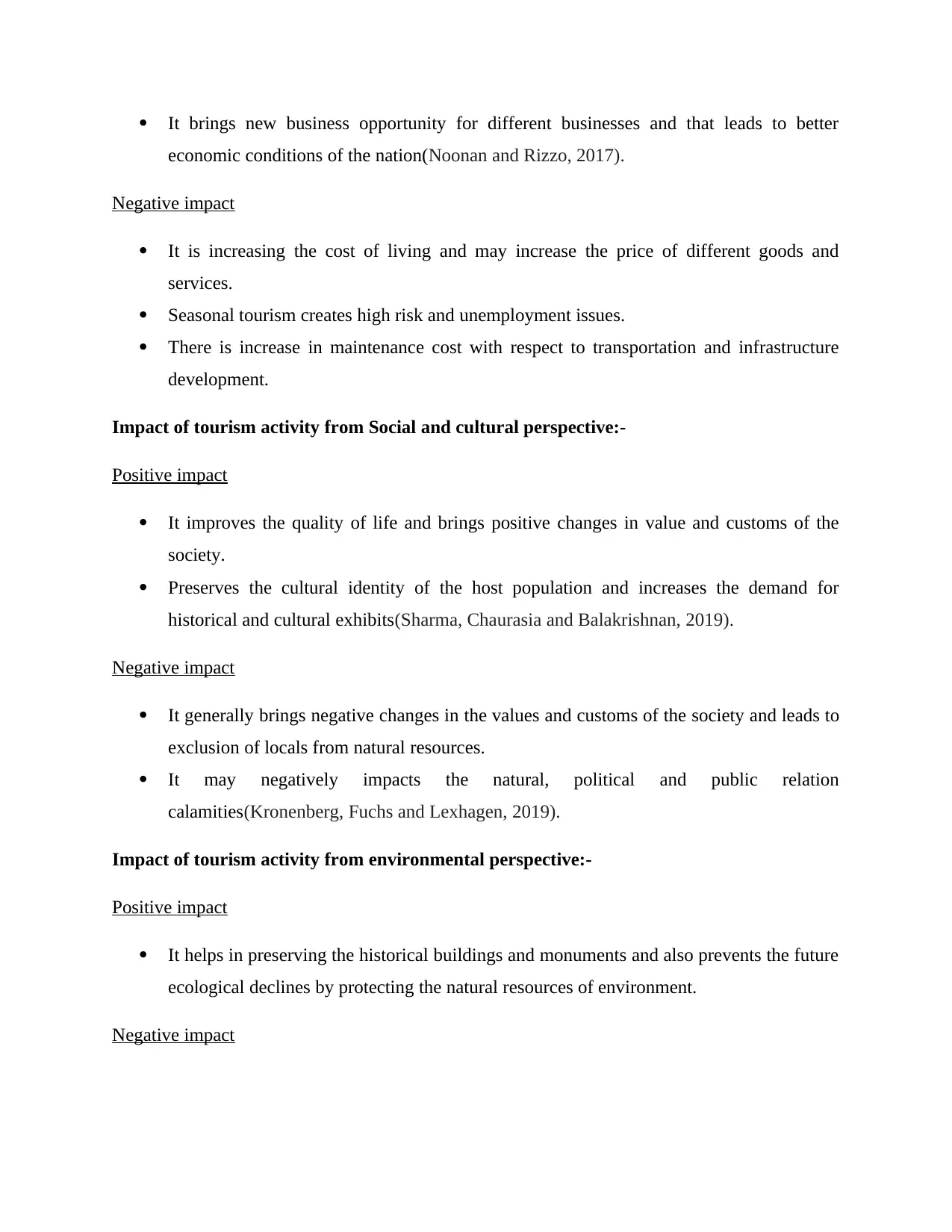
It brings new business opportunity for different businesses and that leads to better
economic conditions of the nation(Noonan and Rizzo, 2017).
Negative impact
It is increasing the cost of living and may increase the price of different goods and
services.
Seasonal tourism creates high risk and unemployment issues.
There is increase in maintenance cost with respect to transportation and infrastructure
development.
Impact of tourism activity from Social and cultural perspective:-
Positive impact
It improves the quality of life and brings positive changes in value and customs of the
society.
Preserves the cultural identity of the host population and increases the demand for
historical and cultural exhibits(Sharma, Chaurasia and Balakrishnan, 2019).
Negative impact
It generally brings negative changes in the values and customs of the society and leads to
exclusion of locals from natural resources.
It may negatively impacts the natural, political and public relation
calamities(Kronenberg, Fuchs and Lexhagen, 2019).
Impact of tourism activity from environmental perspective:-
Positive impact
It helps in preserving the historical buildings and monuments and also prevents the future
ecological declines by protecting the natural resources of environment.
Negative impact
economic conditions of the nation(Noonan and Rizzo, 2017).
Negative impact
It is increasing the cost of living and may increase the price of different goods and
services.
Seasonal tourism creates high risk and unemployment issues.
There is increase in maintenance cost with respect to transportation and infrastructure
development.
Impact of tourism activity from Social and cultural perspective:-
Positive impact
It improves the quality of life and brings positive changes in value and customs of the
society.
Preserves the cultural identity of the host population and increases the demand for
historical and cultural exhibits(Sharma, Chaurasia and Balakrishnan, 2019).
Negative impact
It generally brings negative changes in the values and customs of the society and leads to
exclusion of locals from natural resources.
It may negatively impacts the natural, political and public relation
calamities(Kronenberg, Fuchs and Lexhagen, 2019).
Impact of tourism activity from environmental perspective:-
Positive impact
It helps in preserving the historical buildings and monuments and also prevents the future
ecological declines by protecting the natural resources of environment.
Negative impact
Secure Best Marks with AI Grader
Need help grading? Try our AI Grader for instant feedback on your assignments.
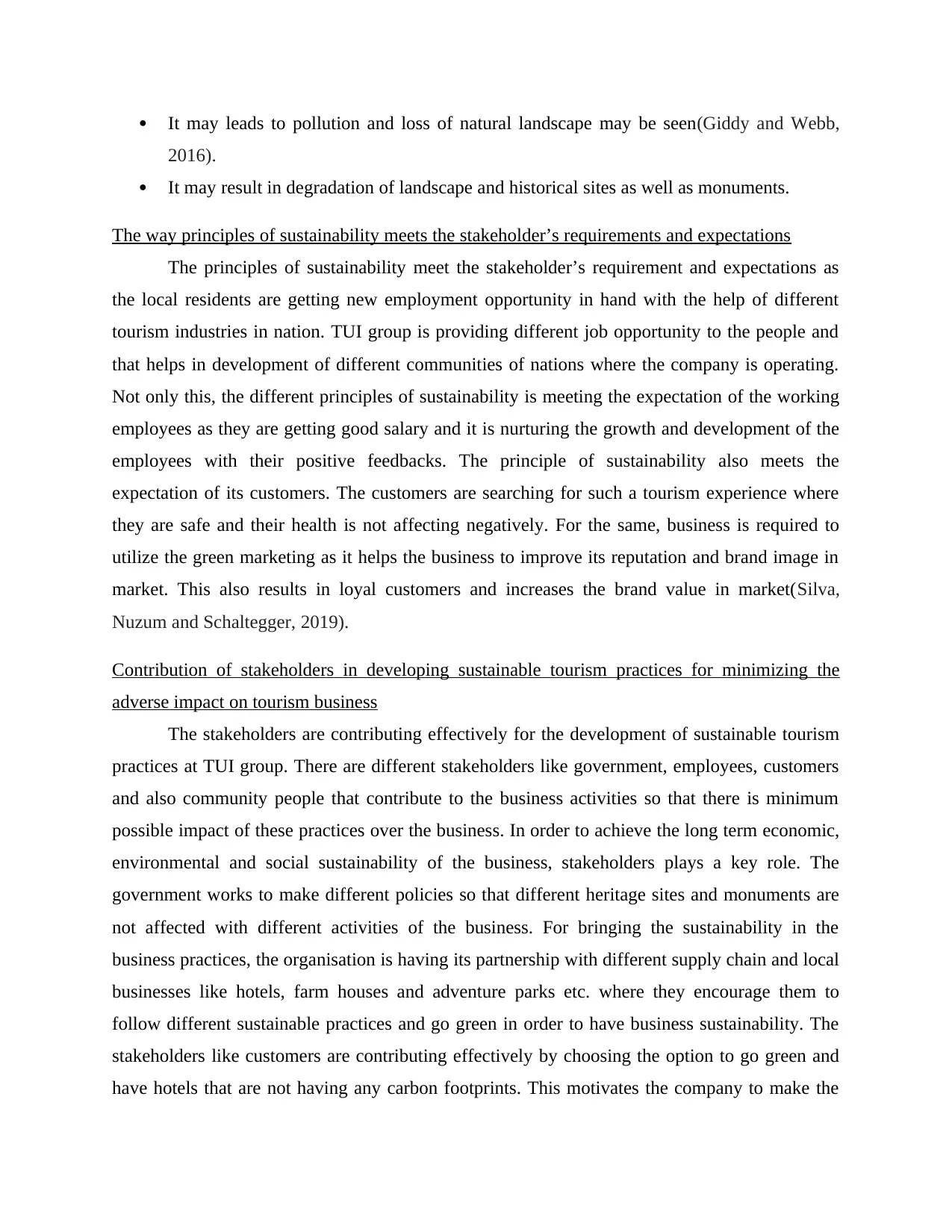
It may leads to pollution and loss of natural landscape may be seen(Giddy and Webb,
2016).
It may result in degradation of landscape and historical sites as well as monuments.
The way principles of sustainability meets the stakeholder’s requirements and expectations
The principles of sustainability meet the stakeholder’s requirement and expectations as
the local residents are getting new employment opportunity in hand with the help of different
tourism industries in nation. TUI group is providing different job opportunity to the people and
that helps in development of different communities of nations where the company is operating.
Not only this, the different principles of sustainability is meeting the expectation of the working
employees as they are getting good salary and it is nurturing the growth and development of the
employees with their positive feedbacks. The principle of sustainability also meets the
expectation of its customers. The customers are searching for such a tourism experience where
they are safe and their health is not affecting negatively. For the same, business is required to
utilize the green marketing as it helps the business to improve its reputation and brand image in
market. This also results in loyal customers and increases the brand value in market(Silva,
Nuzum and Schaltegger, 2019).
Contribution of stakeholders in developing sustainable tourism practices for minimizing the
adverse impact on tourism business
The stakeholders are contributing effectively for the development of sustainable tourism
practices at TUI group. There are different stakeholders like government, employees, customers
and also community people that contribute to the business activities so that there is minimum
possible impact of these practices over the business. In order to achieve the long term economic,
environmental and social sustainability of the business, stakeholders plays a key role. The
government works to make different policies so that different heritage sites and monuments are
not affected with different activities of the business. For bringing the sustainability in the
business practices, the organisation is having its partnership with different supply chain and local
businesses like hotels, farm houses and adventure parks etc. where they encourage them to
follow different sustainable practices and go green in order to have business sustainability. The
stakeholders like customers are contributing effectively by choosing the option to go green and
have hotels that are not having any carbon footprints. This motivates the company to make the
2016).
It may result in degradation of landscape and historical sites as well as monuments.
The way principles of sustainability meets the stakeholder’s requirements and expectations
The principles of sustainability meet the stakeholder’s requirement and expectations as
the local residents are getting new employment opportunity in hand with the help of different
tourism industries in nation. TUI group is providing different job opportunity to the people and
that helps in development of different communities of nations where the company is operating.
Not only this, the different principles of sustainability is meeting the expectation of the working
employees as they are getting good salary and it is nurturing the growth and development of the
employees with their positive feedbacks. The principle of sustainability also meets the
expectation of its customers. The customers are searching for such a tourism experience where
they are safe and their health is not affecting negatively. For the same, business is required to
utilize the green marketing as it helps the business to improve its reputation and brand image in
market. This also results in loyal customers and increases the brand value in market(Silva,
Nuzum and Schaltegger, 2019).
Contribution of stakeholders in developing sustainable tourism practices for minimizing the
adverse impact on tourism business
The stakeholders are contributing effectively for the development of sustainable tourism
practices at TUI group. There are different stakeholders like government, employees, customers
and also community people that contribute to the business activities so that there is minimum
possible impact of these practices over the business. In order to achieve the long term economic,
environmental and social sustainability of the business, stakeholders plays a key role. The
government works to make different policies so that different heritage sites and monuments are
not affected with different activities of the business. For bringing the sustainability in the
business practices, the organisation is having its partnership with different supply chain and local
businesses like hotels, farm houses and adventure parks etc. where they encourage them to
follow different sustainable practices and go green in order to have business sustainability. The
stakeholders like customers are contributing effectively by choosing the option to go green and
have hotels that are not having any carbon footprints. This motivates the company to make the
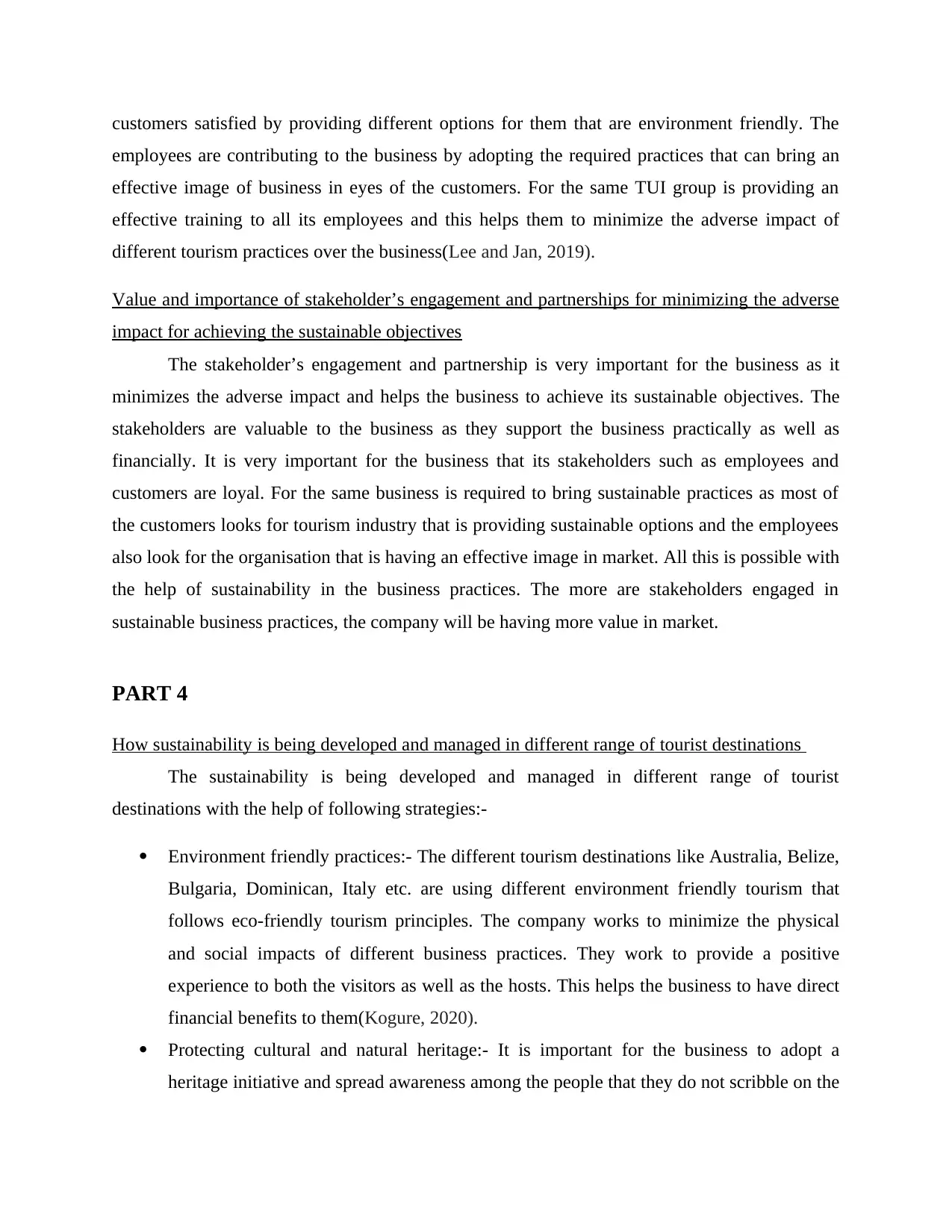
customers satisfied by providing different options for them that are environment friendly. The
employees are contributing to the business by adopting the required practices that can bring an
effective image of business in eyes of the customers. For the same TUI group is providing an
effective training to all its employees and this helps them to minimize the adverse impact of
different tourism practices over the business(Lee and Jan, 2019).
Value and importance of stakeholder’s engagement and partnerships for minimizing the adverse
impact for achieving the sustainable objectives
The stakeholder’s engagement and partnership is very important for the business as it
minimizes the adverse impact and helps the business to achieve its sustainable objectives. The
stakeholders are valuable to the business as they support the business practically as well as
financially. It is very important for the business that its stakeholders such as employees and
customers are loyal. For the same business is required to bring sustainable practices as most of
the customers looks for tourism industry that is providing sustainable options and the employees
also look for the organisation that is having an effective image in market. All this is possible with
the help of sustainability in the business practices. The more are stakeholders engaged in
sustainable business practices, the company will be having more value in market.
PART 4
How sustainability is being developed and managed in different range of tourist destinations
The sustainability is being developed and managed in different range of tourist
destinations with the help of following strategies:-
Environment friendly practices:- The different tourism destinations like Australia, Belize,
Bulgaria, Dominican, Italy etc. are using different environment friendly tourism that
follows eco-friendly tourism principles. The company works to minimize the physical
and social impacts of different business practices. They work to provide a positive
experience to both the visitors as well as the hosts. This helps the business to have direct
financial benefits to them(Kogure, 2020).
Protecting cultural and natural heritage:- It is important for the business to adopt a
heritage initiative and spread awareness among the people that they do not scribble on the
employees are contributing to the business by adopting the required practices that can bring an
effective image of business in eyes of the customers. For the same TUI group is providing an
effective training to all its employees and this helps them to minimize the adverse impact of
different tourism practices over the business(Lee and Jan, 2019).
Value and importance of stakeholder’s engagement and partnerships for minimizing the adverse
impact for achieving the sustainable objectives
The stakeholder’s engagement and partnership is very important for the business as it
minimizes the adverse impact and helps the business to achieve its sustainable objectives. The
stakeholders are valuable to the business as they support the business practically as well as
financially. It is very important for the business that its stakeholders such as employees and
customers are loyal. For the same business is required to bring sustainable practices as most of
the customers looks for tourism industry that is providing sustainable options and the employees
also look for the organisation that is having an effective image in market. All this is possible with
the help of sustainability in the business practices. The more are stakeholders engaged in
sustainable business practices, the company will be having more value in market.
PART 4
How sustainability is being developed and managed in different range of tourist destinations
The sustainability is being developed and managed in different range of tourist
destinations with the help of following strategies:-
Environment friendly practices:- The different tourism destinations like Australia, Belize,
Bulgaria, Dominican, Italy etc. are using different environment friendly tourism that
follows eco-friendly tourism principles. The company works to minimize the physical
and social impacts of different business practices. They work to provide a positive
experience to both the visitors as well as the hosts. This helps the business to have direct
financial benefits to them(Kogure, 2020).
Protecting cultural and natural heritage:- It is important for the business to adopt a
heritage initiative and spread awareness among the people that they do not scribble on the
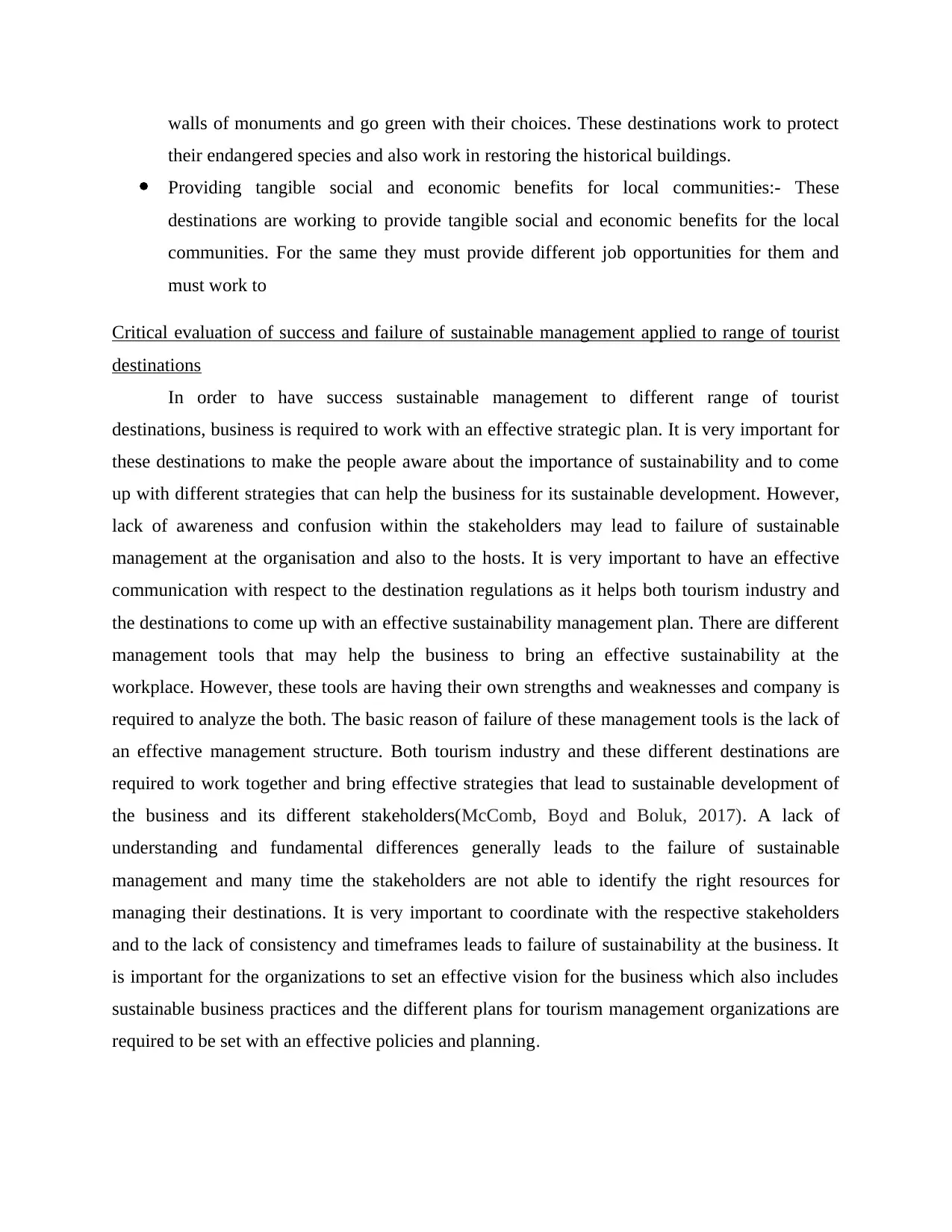
walls of monuments and go green with their choices. These destinations work to protect
their endangered species and also work in restoring the historical buildings.
Providing tangible social and economic benefits for local communities:- These
destinations are working to provide tangible social and economic benefits for the local
communities. For the same they must provide different job opportunities for them and
must work to
Critical evaluation of success and failure of sustainable management applied to range of tourist
destinations
In order to have success sustainable management to different range of tourist
destinations, business is required to work with an effective strategic plan. It is very important for
these destinations to make the people aware about the importance of sustainability and to come
up with different strategies that can help the business for its sustainable development. However,
lack of awareness and confusion within the stakeholders may lead to failure of sustainable
management at the organisation and also to the hosts. It is very important to have an effective
communication with respect to the destination regulations as it helps both tourism industry and
the destinations to come up with an effective sustainability management plan. There are different
management tools that may help the business to bring an effective sustainability at the
workplace. However, these tools are having their own strengths and weaknesses and company is
required to analyze the both. The basic reason of failure of these management tools is the lack of
an effective management structure. Both tourism industry and these different destinations are
required to work together and bring effective strategies that lead to sustainable development of
the business and its different stakeholders(McComb, Boyd and Boluk, 2017). A lack of
understanding and fundamental differences generally leads to the failure of sustainable
management and many time the stakeholders are not able to identify the right resources for
managing their destinations. It is very important to coordinate with the respective stakeholders
and to the lack of consistency and timeframes leads to failure of sustainability at the business. It
is important for the organizations to set an effective vision for the business which also includes
sustainable business practices and the different plans for tourism management organizations are
required to be set with an effective policies and planning.
their endangered species and also work in restoring the historical buildings.
Providing tangible social and economic benefits for local communities:- These
destinations are working to provide tangible social and economic benefits for the local
communities. For the same they must provide different job opportunities for them and
must work to
Critical evaluation of success and failure of sustainable management applied to range of tourist
destinations
In order to have success sustainable management to different range of tourist
destinations, business is required to work with an effective strategic plan. It is very important for
these destinations to make the people aware about the importance of sustainability and to come
up with different strategies that can help the business for its sustainable development. However,
lack of awareness and confusion within the stakeholders may lead to failure of sustainable
management at the organisation and also to the hosts. It is very important to have an effective
communication with respect to the destination regulations as it helps both tourism industry and
the destinations to come up with an effective sustainability management plan. There are different
management tools that may help the business to bring an effective sustainability at the
workplace. However, these tools are having their own strengths and weaknesses and company is
required to analyze the both. The basic reason of failure of these management tools is the lack of
an effective management structure. Both tourism industry and these different destinations are
required to work together and bring effective strategies that lead to sustainable development of
the business and its different stakeholders(McComb, Boyd and Boluk, 2017). A lack of
understanding and fundamental differences generally leads to the failure of sustainable
management and many time the stakeholders are not able to identify the right resources for
managing their destinations. It is very important to coordinate with the respective stakeholders
and to the lack of consistency and timeframes leads to failure of sustainability at the business. It
is important for the organizations to set an effective vision for the business which also includes
sustainable business practices and the different plans for tourism management organizations are
required to be set with an effective policies and planning.
Paraphrase This Document
Need a fresh take? Get an instant paraphrase of this document with our AI Paraphraser
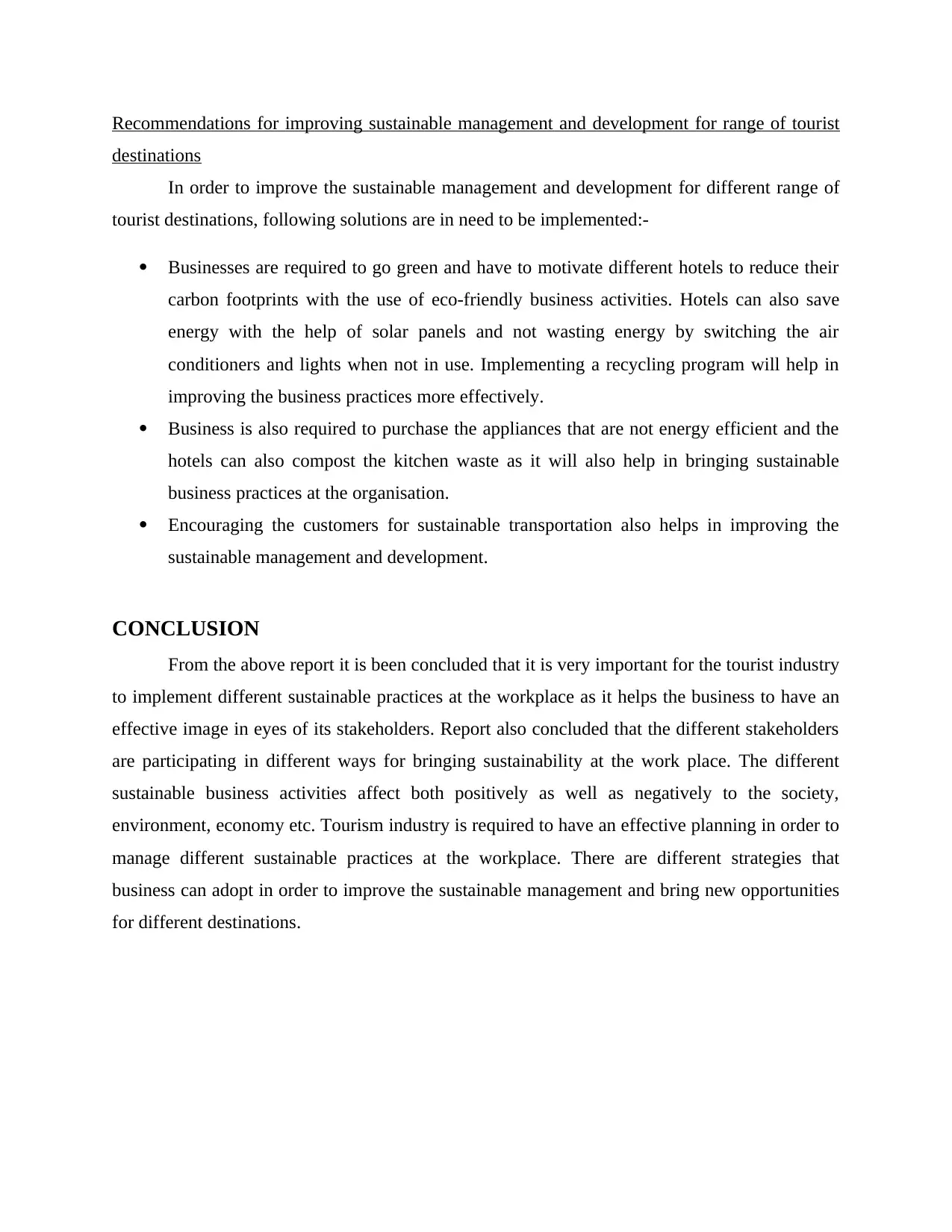
Recommendations for improving sustainable management and development for range of tourist
destinations
In order to improve the sustainable management and development for different range of
tourist destinations, following solutions are in need to be implemented:-
Businesses are required to go green and have to motivate different hotels to reduce their
carbon footprints with the use of eco-friendly business activities. Hotels can also save
energy with the help of solar panels and not wasting energy by switching the air
conditioners and lights when not in use. Implementing a recycling program will help in
improving the business practices more effectively.
Business is also required to purchase the appliances that are not energy efficient and the
hotels can also compost the kitchen waste as it will also help in bringing sustainable
business practices at the organisation.
Encouraging the customers for sustainable transportation also helps in improving the
sustainable management and development.
CONCLUSION
From the above report it is been concluded that it is very important for the tourist industry
to implement different sustainable practices at the workplace as it helps the business to have an
effective image in eyes of its stakeholders. Report also concluded that the different stakeholders
are participating in different ways for bringing sustainability at the work place. The different
sustainable business activities affect both positively as well as negatively to the society,
environment, economy etc. Tourism industry is required to have an effective planning in order to
manage different sustainable practices at the workplace. There are different strategies that
business can adopt in order to improve the sustainable management and bring new opportunities
for different destinations.
destinations
In order to improve the sustainable management and development for different range of
tourist destinations, following solutions are in need to be implemented:-
Businesses are required to go green and have to motivate different hotels to reduce their
carbon footprints with the use of eco-friendly business activities. Hotels can also save
energy with the help of solar panels and not wasting energy by switching the air
conditioners and lights when not in use. Implementing a recycling program will help in
improving the business practices more effectively.
Business is also required to purchase the appliances that are not energy efficient and the
hotels can also compost the kitchen waste as it will also help in bringing sustainable
business practices at the organisation.
Encouraging the customers for sustainable transportation also helps in improving the
sustainable management and development.
CONCLUSION
From the above report it is been concluded that it is very important for the tourist industry
to implement different sustainable practices at the workplace as it helps the business to have an
effective image in eyes of its stakeholders. Report also concluded that the different stakeholders
are participating in different ways for bringing sustainability at the work place. The different
sustainable business activities affect both positively as well as negatively to the society,
environment, economy etc. Tourism industry is required to have an effective planning in order to
manage different sustainable practices at the workplace. There are different strategies that
business can adopt in order to improve the sustainable management and bring new opportunities
for different destinations.
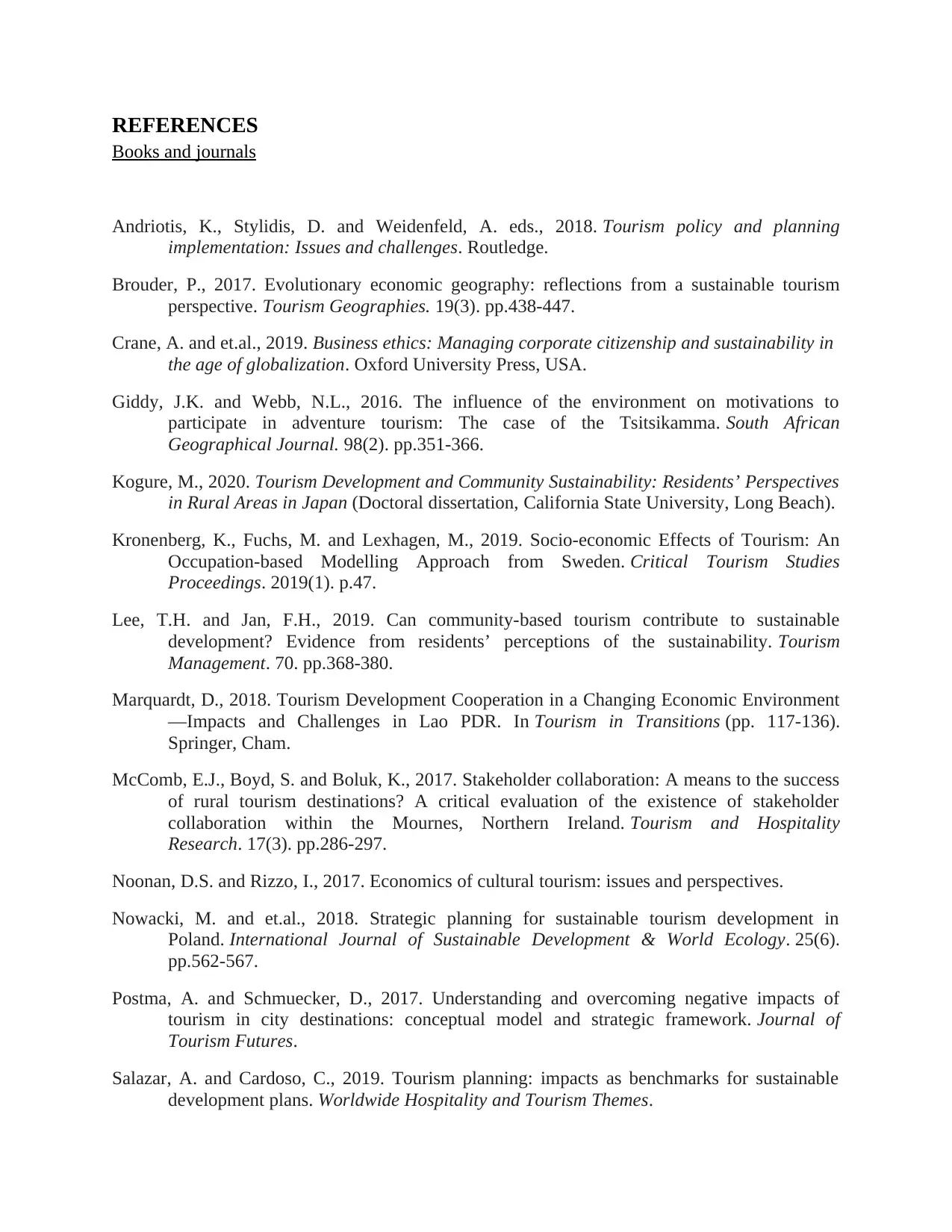
REFERENCES
Books and journals
Andriotis, K., Stylidis, D. and Weidenfeld, A. eds., 2018. Tourism policy and planning
implementation: Issues and challenges. Routledge.
Brouder, P., 2017. Evolutionary economic geography: reflections from a sustainable tourism
perspective. Tourism Geographies. 19(3). pp.438-447.
Crane, A. and et.al., 2019. Business ethics: Managing corporate citizenship and sustainability in
the age of globalization. Oxford University Press, USA.
Giddy, J.K. and Webb, N.L., 2016. The influence of the environment on motivations to
participate in adventure tourism: The case of the Tsitsikamma. South African
Geographical Journal. 98(2). pp.351-366.
Kogure, M., 2020. Tourism Development and Community Sustainability: Residents’ Perspectives
in Rural Areas in Japan (Doctoral dissertation, California State University, Long Beach).
Kronenberg, K., Fuchs, M. and Lexhagen, M., 2019. Socio-economic Effects of Tourism: An
Occupation-based Modelling Approach from Sweden. Critical Tourism Studies
Proceedings. 2019(1). p.47.
Lee, T.H. and Jan, F.H., 2019. Can community-based tourism contribute to sustainable
development? Evidence from residents’ perceptions of the sustainability. Tourism
Management. 70. pp.368-380.
Marquardt, D., 2018. Tourism Development Cooperation in a Changing Economic Environment
—Impacts and Challenges in Lao PDR. In Tourism in Transitions (pp. 117-136).
Springer, Cham.
McComb, E.J., Boyd, S. and Boluk, K., 2017. Stakeholder collaboration: A means to the success
of rural tourism destinations? A critical evaluation of the existence of stakeholder
collaboration within the Mournes, Northern Ireland. Tourism and Hospitality
Research. 17(3). pp.286-297.
Noonan, D.S. and Rizzo, I., 2017. Economics of cultural tourism: issues and perspectives.
Nowacki, M. and et.al., 2018. Strategic planning for sustainable tourism development in
Poland. International Journal of Sustainable Development & World Ecology. 25(6).
pp.562-567.
Postma, A. and Schmuecker, D., 2017. Understanding and overcoming negative impacts of
tourism in city destinations: conceptual model and strategic framework. Journal of
Tourism Futures.
Salazar, A. and Cardoso, C., 2019. Tourism planning: impacts as benchmarks for sustainable
development plans. Worldwide Hospitality and Tourism Themes.
Books and journals
Andriotis, K., Stylidis, D. and Weidenfeld, A. eds., 2018. Tourism policy and planning
implementation: Issues and challenges. Routledge.
Brouder, P., 2017. Evolutionary economic geography: reflections from a sustainable tourism
perspective. Tourism Geographies. 19(3). pp.438-447.
Crane, A. and et.al., 2019. Business ethics: Managing corporate citizenship and sustainability in
the age of globalization. Oxford University Press, USA.
Giddy, J.K. and Webb, N.L., 2016. The influence of the environment on motivations to
participate in adventure tourism: The case of the Tsitsikamma. South African
Geographical Journal. 98(2). pp.351-366.
Kogure, M., 2020. Tourism Development and Community Sustainability: Residents’ Perspectives
in Rural Areas in Japan (Doctoral dissertation, California State University, Long Beach).
Kronenberg, K., Fuchs, M. and Lexhagen, M., 2019. Socio-economic Effects of Tourism: An
Occupation-based Modelling Approach from Sweden. Critical Tourism Studies
Proceedings. 2019(1). p.47.
Lee, T.H. and Jan, F.H., 2019. Can community-based tourism contribute to sustainable
development? Evidence from residents’ perceptions of the sustainability. Tourism
Management. 70. pp.368-380.
Marquardt, D., 2018. Tourism Development Cooperation in a Changing Economic Environment
—Impacts and Challenges in Lao PDR. In Tourism in Transitions (pp. 117-136).
Springer, Cham.
McComb, E.J., Boyd, S. and Boluk, K., 2017. Stakeholder collaboration: A means to the success
of rural tourism destinations? A critical evaluation of the existence of stakeholder
collaboration within the Mournes, Northern Ireland. Tourism and Hospitality
Research. 17(3). pp.286-297.
Noonan, D.S. and Rizzo, I., 2017. Economics of cultural tourism: issues and perspectives.
Nowacki, M. and et.al., 2018. Strategic planning for sustainable tourism development in
Poland. International Journal of Sustainable Development & World Ecology. 25(6).
pp.562-567.
Postma, A. and Schmuecker, D., 2017. Understanding and overcoming negative impacts of
tourism in city destinations: conceptual model and strategic framework. Journal of
Tourism Futures.
Salazar, A. and Cardoso, C., 2019. Tourism planning: impacts as benchmarks for sustainable
development plans. Worldwide Hospitality and Tourism Themes.
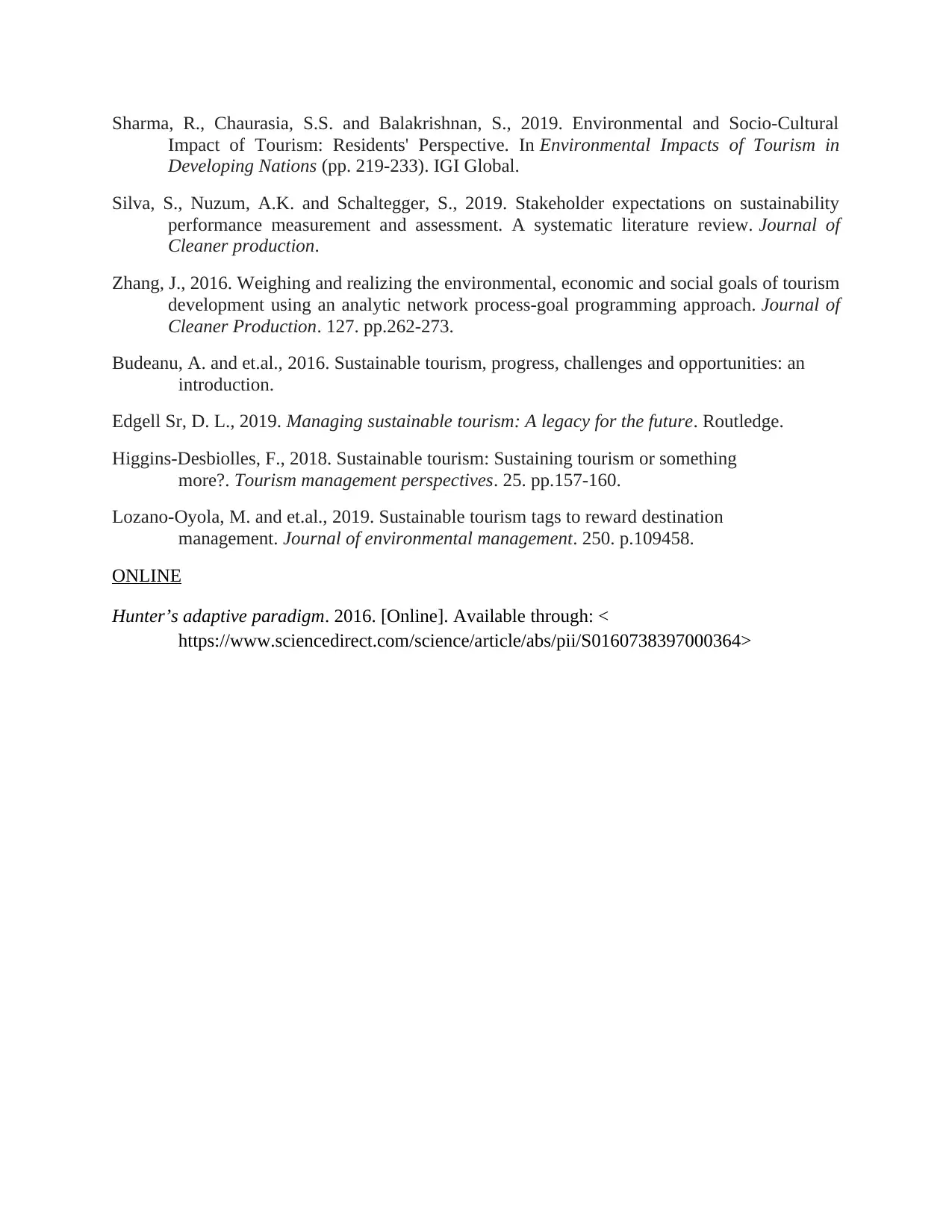
Sharma, R., Chaurasia, S.S. and Balakrishnan, S., 2019. Environmental and Socio-Cultural
Impact of Tourism: Residents' Perspective. In Environmental Impacts of Tourism in
Developing Nations (pp. 219-233). IGI Global.
Silva, S., Nuzum, A.K. and Schaltegger, S., 2019. Stakeholder expectations on sustainability
performance measurement and assessment. A systematic literature review. Journal of
Cleaner production.
Zhang, J., 2016. Weighing and realizing the environmental, economic and social goals of tourism
development using an analytic network process-goal programming approach. Journal of
Cleaner Production. 127. pp.262-273.
Budeanu, A. and et.al., 2016. Sustainable tourism, progress, challenges and opportunities: an
introduction.
Edgell Sr, D. L., 2019. Managing sustainable tourism: A legacy for the future. Routledge.
Higgins-Desbiolles, F., 2018. Sustainable tourism: Sustaining tourism or something
more?. Tourism management perspectives. 25. pp.157-160.
Lozano-Oyola, M. and et.al., 2019. Sustainable tourism tags to reward destination
management. Journal of environmental management. 250. p.109458.
ONLINE
Hunter’s adaptive paradigm. 2016. [Online]. Available through: <
https://www.sciencedirect.com/science/article/abs/pii/S0160738397000364>
Impact of Tourism: Residents' Perspective. In Environmental Impacts of Tourism in
Developing Nations (pp. 219-233). IGI Global.
Silva, S., Nuzum, A.K. and Schaltegger, S., 2019. Stakeholder expectations on sustainability
performance measurement and assessment. A systematic literature review. Journal of
Cleaner production.
Zhang, J., 2016. Weighing and realizing the environmental, economic and social goals of tourism
development using an analytic network process-goal programming approach. Journal of
Cleaner Production. 127. pp.262-273.
Budeanu, A. and et.al., 2016. Sustainable tourism, progress, challenges and opportunities: an
introduction.
Edgell Sr, D. L., 2019. Managing sustainable tourism: A legacy for the future. Routledge.
Higgins-Desbiolles, F., 2018. Sustainable tourism: Sustaining tourism or something
more?. Tourism management perspectives. 25. pp.157-160.
Lozano-Oyola, M. and et.al., 2019. Sustainable tourism tags to reward destination
management. Journal of environmental management. 250. p.109458.
ONLINE
Hunter’s adaptive paradigm. 2016. [Online]. Available through: <
https://www.sciencedirect.com/science/article/abs/pii/S0160738397000364>
1 out of 16
Related Documents
Your All-in-One AI-Powered Toolkit for Academic Success.
+13062052269
info@desklib.com
Available 24*7 on WhatsApp / Email
![[object Object]](/_next/static/media/star-bottom.7253800d.svg)
Unlock your academic potential
© 2024 | Zucol Services PVT LTD | All rights reserved.




